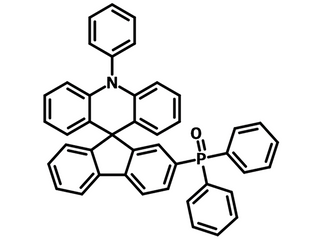POSTF
CAS Number 1647050-25-6
High Purity Sublimed Materials, Host Materials, Materials, OLED Materials,POSTF, high quality and high purity bipolar host material
Phosphorescent host for highly efficient blue, green and red phosphorescence devices, 2'-(Diphenylphosphoryl)-10-phenyl-10H-spiro[acridine-9,9'-fluorene], CAS No. 1647050-25-6, Sublimed ≥99.0%
POSTF has an orthogonal molecular structure with an electron donating spiro[acridine-9,9'-fluorene] core and one electron withdrawing diphenylphosphine oxide attachment to the fluorene unit at 2-poistion.
Bipolar POSTF can be used as a single or together with PO-T2T as an exciplex phosphorescent host for highly efficient blue, green and red phosphorescence devices. Using POSTF as the host, large-size white light-emitting panel (15 cm × 15 cm) with max power efficiency of 75.9 lm W-1 can be achieved [1].
General Information
| CAS number | 1647050-25-6 |
|---|---|
| Full name | 2'-(Diphenylphosphoryl)-10-phenyl-10H-spiro[acridine-9,9'-fluorene] |
| Chemical formula | C43H30NOP |
| Molecular weight | 607.68 g/mol |
| Absorption | λmax 280 nm, 325 nm (in DCM) |
| Phosphorescene | λmax 430 nm (in DCM) |
| HOMO/LUMO | HOMO = 5.57 eV, LUMO = 2.12 eV [1] |
| Synonyms | Diphenyl(10-phenyl-10H-spiro[acridine-9,9'-fluoren]-2'-yl)phosphine oxide |
| Classification / Family | Spiro[acridine-9,9'-fluorene] derivatives, Light-emitting diodes, Bipolar host, TADF host materials, Sublimed materials. |
Product Details
| Purity | Sublimed >99.0% (HPLC) |
|---|---|
| Melting point | Tg = 160 ℃, Td (Temperature at 5% weight loss) = 356 ℃. |
| Appearance | White powder/crystals |
*Sublimation is a technique used to obtain ultra pure-grade chemicals. For more details about sublimation, please refer to the Sublimed Materials.
Chemical Structure
Device Structure(s)
| Device structure | ITO/HAT-CN (10 nm)/TAPC (45 nm)/POSTF: FIrpic (15 vol%, 20 nm)/TmPyPB (40 nm)/Liq (2 nm)/Al [1] |
|---|---|
| Color |
|
| Max. Power Efficiency | 50.5 lm W-1 |
| Max. EQE | 26.8% |
| Device structure | ITO/HAT-CN/TAPC/POSTF/POSTF:POT2T:15 mol% FIrpic/POSTF:PO-T2T:Ir(MDQ)2(acac)/PO-T2T/Liq/Al [2] |
|---|---|
| Color |
|
| Max. Power Efficiency | 60.7 lm W-1 |
| Max. EQE | 24.7% |
| Device structure | ITO/HAT-CN/TAPC/ POSTF/POSTF:PO-T2T: 15% FIrpic (CRS)/PO-T2T/Liq/Al [2] |
|---|---|
| Color |
|
| Max. Power Efficiency | 34.7 lm W-1 |
| Max. EQE | 20.1% |
| Device structure | ITO/HAT-CN/TAPC/ POSTF/POSTF:PO-T2T: 15% FIrpic (CRS)/PO-T2T/Liq/Al [2] |
|---|---|
| Color |
|
| Max. Power Efficiency | 57.4 lm W-1 |
| Max. EQE | 19.3% |
| Device structure | ITO/HAT-CN/TAPC/ POSTF/POSTF:PO-T2T: 15% Ir(MDQ)2(acac) (CRS)/PO-T2T/Liq/Al [2] |
|---|---|
| Color |
|
| Max. Power Efficiency | 46.0 lm W-1 |
| Max. EQE | 27.6% |
*For chemical structure information, please refer to the cited references.
Pricing
| Grade | Order Code | Quantity | Price |
|---|---|---|---|
| Sublimed (>99.0% purity) | M2337A1 | 250 mg | £380 |
| Sublimed (>99.0% purity) | M2337A1 | 500 mg | £660 |
| Sublimed (>99.0% purity) | M2337A1 | 1 g | £1150 |
MSDS Documentation
Literature and Reviews
- Orthogonal Molecular Structure for Better Host Material in Blue Phosphorescence and Larger OLED White Lighting, L. Ding et al., Adv. Funct. Mater., 25 (4); 645-650 (2015); DOI: 10.1002/adfm.201403402.
- High-Quality White Organic Light-Emitting Diodes Composed of Binary Emitters with Color Rendering Index Exceeding 80 by Utilizing Color Remedy Strategy, X. Tang et al., Adv. Funct. Mater., 29 (11); 1807541 (2019); DOI: 10.1002/adfm.201807541.
- Theoretical Investigations of the Spiro-Annulated Triphenylamine/ N-Phenylcarbazole-Based Ambipolar Host Materials for OLEDs, D. Zhang, et al., ChemistrySelect, 2 (22), 6604-6611 (2017); DOI: 10.1002/slct.201701424.

